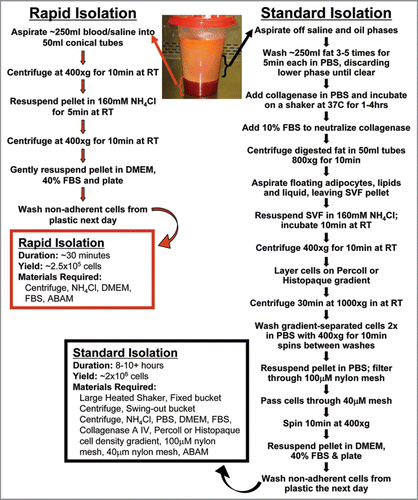Figures & data
Figure 1 Adipose-derived stem cell isolation techniques flow chart. The wide variance in the time, materials, and effort for obtaining ASCs via the Standard Isolation and our Rapid Isolation techniques is shown. A highly viable population of around 250,000 ASCs can be derived from 250 ml of blood/saline fraction of the liposuction waste in as little as 30 minutes, as compared to 8–10 hours to obtain ASCs using the traditional isolation method. SVF, stromal vascular fraction; ABAM, antibiotic/antimycotic; FBS, fetal bovine serum.

Figure 2 Characterization of ASC differentiation. The differentiation potential of ASCs isolated in the streamlined, rapid protocol were compared to ASCs isolated using the standard protocol (traditional ASCs). Cells were induced to differentiate into adipocytes ((A) for rapid ASCs and (G) for traditional ASCs; (D) rapid ASCs grown for 2 weeks without adipogenic media as control; all stained with oil red O and hematoxlin), osteocytes ((B) for rapid ASCs and (H) for traditional ASCs; (E) rapid ASCs grown 2 weeks without osteocyte induction media as control; all stained with Alizarin red S and hematoxylin), and chondrocytes [(C) for rapid ASCs and (I) for traditional ASCs, both in a micromass (solid micromass pellet, insert, (C)]; (F) unpelleted rapid ASCs grown 4 weeks in induction media as control; all samples stained for Safranin O).
![Figure 2 Characterization of ASC differentiation. The differentiation potential of ASCs isolated in the streamlined, rapid protocol were compared to ASCs isolated using the standard protocol (traditional ASCs). Cells were induced to differentiate into adipocytes ((A) for rapid ASCs and (G) for traditional ASCs; (D) rapid ASCs grown for 2 weeks without adipogenic media as control; all stained with oil red O and hematoxlin), osteocytes ((B) for rapid ASCs and (H) for traditional ASCs; (E) rapid ASCs grown 2 weeks without osteocyte induction media as control; all stained with Alizarin red S and hematoxylin), and chondrocytes [(C) for rapid ASCs and (I) for traditional ASCs, both in a micromass (solid micromass pellet, insert, (C)]; (F) unpelleted rapid ASCs grown 4 weeks in induction media as control; all samples stained for Safranin O).](/cms/asset/9ee2896e-21bb-4eb5-a725-95d2e6159d54/kogg_a_10910019_f0002.gif)
Table 1 Immunophenotype of ASCs isolated using the rapid and standard protocols
Table 2 EGF supplemented ASC media enhances growth